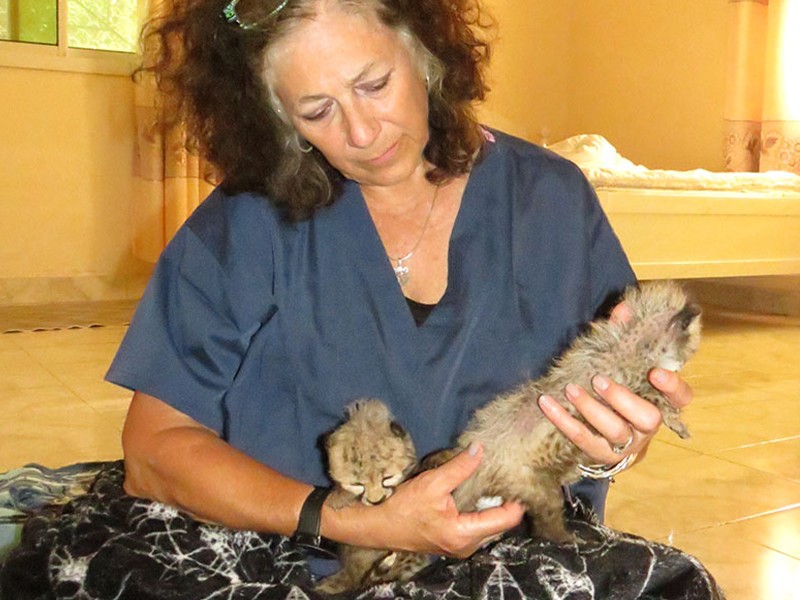Can You Get A Pet Cheetah? This is a common question, but owning a cheetah is more complex than many realize; PETS.EDU.VN is here to provide insight. Exploring exotic pet ownership reveals ethical, legal, and practical considerations, and we will explore why cheetahs should remain in the wild, discussing cheetah conservation, wildlife protection, and the illegal pet trade.
1. The Allure of Exotic Pets: A Misguided Dream
The allure of owning an exotic pet, such as a cheetah, often stems from a desire for uniqueness and status. Movies and social media might depict exotic animals as glamorous companions, but these portrayals rarely show the realities of caring for such a creature. The truth is that exotic pets demand specialized care that most owners cannot provide, leading to animal suffering and contributing to conservation problems.
1.1. Understanding the Appeal
Many people are drawn to the idea of owning a cheetah due to their beauty, speed, and association with power. The thought of having such a magnificent creature as a pet can seem exciting, but it’s essential to consider the animal’s needs and the ethical implications. Cheetahs are wild animals, and their instincts and behaviors are not suited to domestic life.
1.2. The Reality of Exotic Pet Ownership
Exotic pet ownership comes with several challenges:
- Specialized Care: Exotic pets require specific diets, habitats, and veterinary care that are often difficult and expensive to obtain.
- Ethical Concerns: Removing animals from their natural habitats disrupts ecosystems and can lead to population declines.
- Legal Restrictions: Many areas have strict laws regarding the ownership of exotic animals, and violating these laws can result in fines or even imprisonment.
1.3. Why Cheetahs Don’t Belong in Homes
Cheetahs, in particular, are ill-suited for domestic life:
- Space Requirements: Cheetahs need vast areas to run and hunt, something impossible to replicate in a typical home environment.
- Dietary Needs: Their diet consists primarily of raw meat, and providing this in a captive setting can be challenging and costly.
- Behavioral Issues: Cheetahs are wild animals with strong instincts; they cannot be fully domesticated and may exhibit unpredictable behavior.
2. Legal Implications: Navigating the Maze
Owning a cheetah is not just a matter of personal preference; it’s a legal issue. Laws regarding exotic animal ownership vary widely by region, and many places have strict regulations or outright bans. Understanding these laws is crucial for anyone considering owning a cheetah, as illegal ownership can lead to severe penalties.
2.1. International Regulations
Several international agreements aim to protect endangered species like cheetahs. The Convention on International Trade in Endangered Species of Wild Fauna and Flora (CITES) regulates the international trade of cheetahs to ensure their survival. CITES classifies cheetahs under Appendix I, meaning that commercial trade is generally prohibited.
2.2. National and Local Laws
National and local laws often mirror international agreements but can also include additional restrictions. Some countries and states have outright bans on owning dangerous or exotic animals, while others require permits and strict compliance with specific standards of care.
2.3. Penalties for Illegal Ownership
The penalties for illegally owning a cheetah can be severe:
- Fines: Ranging from hundreds to thousands of dollars.
- Confiscation: The animal may be seized and placed in a sanctuary or zoo.
- Imprisonment: In some cases, illegal owners may face jail time.
3. Ethical Considerations: The Welfare of Cheetahs
Beyond the legal aspects, ethical considerations play a significant role in the debate over owning cheetahs. Keeping a wild animal in captivity raises questions about animal welfare, conservation, and the impact on natural ecosystems.
3.1. The Impact on Cheetah Welfare
Cheetahs in captivity often suffer from:
- Stress and Boredom: Limited space and lack of natural stimuli can lead to chronic stress and behavioral problems.
- Health Issues: Captive cheetahs are prone to various health problems, including obesity, dental issues, and weakened immune systems.
- Reduced Lifespan: Captive environments often fail to meet the complex needs of cheetahs, resulting in shorter lifespans compared to their wild counterparts.
3.2. Conservation Concerns
The demand for cheetahs as pets fuels the illegal wildlife trade, which threatens wild populations. Poaching cheetah cubs from their natural habitats disrupts social structures and reduces genetic diversity, further endangering the species.
3.3. Supporting Ethical Alternatives
Instead of supporting the exotic pet trade, individuals can contribute to cheetah conservation through:
- Donations: Supporting conservation organizations that work to protect cheetahs in the wild.
- Education: Raising awareness about the plight of cheetahs and the dangers of the illegal pet trade.
- Responsible Tourism: Visiting cheetah conservation areas and supporting local communities involved in protecting wildlife.
4. Practical Challenges: The Realities of Cheetah Care
Even if it were legal and ethical, owning a cheetah presents numerous practical challenges. These animals have highly specific needs that are difficult and expensive to meet in a domestic setting.
4.1. Dietary Requirements
Cheetahs are obligate carnivores, meaning they must eat meat to survive. Their diet should consist of high-quality raw meat, including bones and organs, to provide essential nutrients.
Dietary Considerations:
| Nutrient | Source | Importance |
|---|---|---|
| Protein | Raw meat (e.g., beef, chicken, rabbit) | Muscle development and maintenance |
| Calcium | Bones | Bone health and nerve function |
| Taurine | Heart and brain tissue | Heart health and vision |
| Vitamin A | Liver | Vision, immune function, and cell growth |
| Essential Fatty Acids | Fish oil, flaxseed oil | Skin and coat health, immune function |


4.2. Housing and Enrichment
Cheetahs require large, secure enclosures that mimic their natural habitat. These enclosures should include:
- Ample Space: Cheetahs need room to run and exercise, ideally several acres.
- Secure Fencing: High, sturdy fences are necessary to prevent escapes and protect the animal from external threats.
- Enrichment: Providing stimulating activities such as climbing structures, scratching posts, and puzzle feeders can help prevent boredom and stress.
4.3. Veterinary Care
Cheetahs require specialized veterinary care from professionals experienced with exotic animals. Regular check-ups, vaccinations, and parasite control are essential for maintaining their health.
Common Health Issues in Captive Cheetahs:
- Gastritis: Inflammation of the stomach lining, often caused by stress or improper diet.
- Dental Disease: Resulting from a lack of natural chewing behavior.
- Kidney Disease: Common in older cheetahs, often linked to diet and hydration.
4.4. Cost Considerations
The cost of caring for a cheetah can be prohibitive. Expenses include:
- Food: High-quality raw meat can cost hundreds of dollars per month.
- Housing: Building and maintaining a suitable enclosure can be very expensive.
- Veterinary Care: Specialized vet visits and treatments can quickly add up.
5. The Illegal Pet Trade: A Threat to Cheetahs
The illegal pet trade poses a significant threat to cheetah populations. Driven by demand for exotic pets, traffickers capture cheetah cubs from the wild, often killing their mothers in the process. The cubs are then smuggled to wealthy buyers, mainly in the Middle East.
5.1. The Impact on Wild Populations
The illegal pet trade has devastating consequences for wild cheetah populations:
- Population Decline: The removal of cubs from the wild reduces the number of breeding adults, leading to population declines.
- Disrupted Social Structures: Cheetahs are social animals, and the loss of cubs can disrupt social bonds and family structures.
- Genetic Diversity: Removing individuals from the wild reduces genetic diversity, making the population more vulnerable to disease and environmental changes.
5.2. The Journey of a Trafficked Cub
The journey from the wild to a domestic home is often traumatic for cheetah cubs:
- Capture: Cubs are often captured violently, and their mothers may be killed in the process.
- Transportation: Cubs are typically transported in cramped, unsanitary conditions, often without food or water.
- Mortality: Many cubs die during transit due to stress, dehydration, and injury.
5.3. Combating the Illegal Trade
Several organizations are working to combat the illegal pet trade:
- Cheetah Conservation Fund (CCF): CCF operates rescue centers for confiscated cheetahs and works to reduce demand for exotic pets through education and advocacy.
- Convention on International Trade in Endangered Species (CITES): CITES regulates the international trade of cheetahs and works to prevent illegal trafficking.
- Local Law Enforcement: Local authorities play a crucial role in enforcing laws against wildlife trafficking and prosecuting offenders.
6. Cheetah Conservation: Protecting the Future
Cheetah conservation is essential for ensuring the survival of these magnificent animals. Conservation efforts focus on protecting their natural habitats, reducing human-wildlife conflict, and combating the illegal pet trade.
6.1. Habitat Protection
Protecting cheetah habitats is crucial for their survival. This involves:
- Establishing Protected Areas: Creating national parks and wildlife reserves where cheetahs can roam freely.
- Managing Land Use: Implementing sustainable land-use practices that minimize habitat destruction.
- Community Involvement: Engaging local communities in conservation efforts to ensure their support and participation.
6.2. Reducing Human-Wildlife Conflict
Cheetahs often come into conflict with humans when they prey on livestock. To reduce this conflict, conservationists use various strategies:
- Livestock Management: Providing training and resources to help farmers protect their livestock from cheetah attacks.
- Compensation Programs: Compensating farmers for livestock losses caused by cheetahs.
- Education: Educating communities about the importance of cheetah conservation and the benefits of coexistence.
6.3. Supporting Conservation Organizations
Individuals can support cheetah conservation by donating to organizations like:
- Cheetah Conservation Fund (CCF): CCF works to protect cheetahs through research, education, and community engagement.
Address: 789 Paw Lane, Petville, CA 91234, United States
Whatsapp: +1 555-987-6543
Website: PETS.EDU.VN - Wildlife Conservation Society (WCS): WCS conducts research and conservation programs around the world, including initiatives focused on cheetahs.
- World Wildlife Fund (WWF): WWF works to protect cheetah habitats and reduce human-wildlife conflict.
7. Historical Perspective: Cheetahs as Status Symbols
The history of cheetahs as pets dates back thousands of years. In ancient civilizations, cheetahs were often kept by royalty and the elite as symbols of wealth and status.
7.1. Ancient Civilizations
- Egypt: Cheetahs were revered in ancient Egypt and were often depicted in royal tombs and artwork.
- India: Indian royalty kept thousands of cheetahs for hunting purposes. During the 16th century, Akbar the Great had more than 39,000 cheetahs.
7.2. Modern Times
- Josephine Baker: In the 1920s, dancer Josephine Baker famously walked the streets of Paris with her pet cheetah, Chiquita.
- Enid Lindeman: Socialite Enid Lindeman was known for walking her diamond-collared cheetah through Hyde Park in London.
7.3. Lessons from History
The historical use of cheetahs as pets provides valuable lessons:
- Unsustainable Practices: Removing cheetahs from the wild to satisfy demand led to population declines, particularly in Asia.
- Ethical Concerns: Keeping wild animals in captivity raises ethical questions about animal welfare and conservation.
- Conservation Imperative: Protecting cheetahs requires a shift away from exploitative practices and towards sustainable conservation efforts.
8. Alternative Ways to Connect with Cheetahs
While owning a cheetah is not a viable or ethical option, there are alternative ways to connect with these amazing animals:
8.1. Visiting Sanctuaries and Zoos
Many reputable sanctuaries and zoos offer opportunities to see cheetahs in a safe and ethical environment. These facilities often support conservation efforts and provide educational programs.
8.2. Supporting Virtual Conservation
Technology allows us to engage with wildlife from afar:
- Live Cams: Many organizations offer live streams of cheetah habitats, allowing you to observe their behavior in real-time.
- Documentaries: Watching documentaries about cheetahs can provide valuable insights into their lives and conservation challenges.
- Virtual Reality: Some conservation groups use VR technology to create immersive experiences that bring you closer to cheetahs in their natural habitat.
8.3. Volunteer Opportunities
Volunteering with cheetah conservation organizations can be a rewarding way to contribute to their protection. Volunteers may assist with research, habitat restoration, or community outreach.
9. Debunking Myths About Cheetahs
Several myths surround cheetahs, often fueled by misinformation and romanticized portrayals. It’s crucial to debunk these myths to promote a more accurate understanding of these animals.
9.1. Myth: Cheetahs Can Be Fully Domesticated
Reality: Cheetahs are wild animals with strong instincts that cannot be fully suppressed. They may become accustomed to human presence, but they retain their wild behaviors and needs.
9.2. Myth: Cheetahs Are Low-Maintenance Pets
Reality: Cheetahs require specialized care that is both time-consuming and expensive. Their dietary, housing, and veterinary needs are far beyond what most people can provide.
9.3. Myth: Owning a Cheetah Doesn’t Harm Wild Populations
Reality: The demand for cheetahs as pets drives the illegal wildlife trade, which has devastating consequences for wild populations.
10. The Role of Education and Awareness
Education and awareness are vital for changing attitudes towards cheetahs and promoting responsible conservation practices.
10.1. Educating the Public
- Schools: Integrating wildlife conservation into school curricula can help children develop an appreciation for nature.
- Community Programs: Conducting community workshops and outreach events can raise awareness about cheetah conservation issues.
- Media Campaigns: Using media platforms to disseminate information about cheetahs and the dangers of the illegal pet trade can reach a broad audience.
10.2. Promoting Responsible Tourism
- Ecotourism: Encouraging tourism that benefits local communities and supports conservation efforts.
- Sustainable Practices: Promoting tourism practices that minimize environmental impact and respect wildlife.
- Visitor Education: Providing visitors with information about cheetahs and the importance of conservation.
10.3. Leveraging Social Media
- Sharing Information: Using social media to share accurate information about cheetahs and conservation issues.
- Debunking Myths: Addressing common misconceptions about cheetahs and promoting responsible attitudes.
- Engaging Followers: Encouraging followers to support conservation efforts and share their experiences.
Understanding the realities of owning a cheetah, from the legal and ethical implications to the practical challenges, is essential. Cheetahs are magnificent creatures that belong in the wild, where they can thrive and contribute to the natural ecosystem. By supporting conservation efforts and promoting responsible attitudes, we can ensure that these animals continue to roam the African savannas for generations to come. To learn more about cheetahs and how you can help, visit pets.edu.vn today.
FAQ: Cheetahs as Pets
- Is it legal to own a cheetah in the United States?
- Laws vary by state, but most states have strict regulations or outright bans on owning exotic animals like cheetahs.
- How much does it cost to care for a cheetah?
- The cost can be prohibitive, including high-quality raw meat, specialized veterinary care, and secure housing, easily costing thousands of dollars per year.
- What do cheetahs eat?
- Cheetahs are obligate carnivores, requiring a diet of high-quality raw meat, including bones and organs.
- How much space does a cheetah need?
- Cheetahs need vast areas to run and exercise, ideally several acres, to mimic their natural habitat.
- Can cheetahs be trained like domestic cats?
- Cheetahs are wild animals and cannot be fully domesticated; they retain their wild behaviors and instincts.
- What are the ethical concerns of owning a cheetah?
- Ethical concerns include animal welfare, conservation, and the impact on natural ecosystems, as keeping a wild animal in captivity raises questions about their well-being.
- How does the illegal pet trade affect cheetah populations?
- The illegal pet trade reduces breeding adults, disrupts social structures, and diminishes genetic diversity in wild cheetah populations.
- What is CITES, and how does it protect cheetahs?
- CITES regulates the international trade of cheetahs to ensure their survival and classifies them under Appendix I, generally prohibiting commercial trade.
- What can I do to help cheetah conservation?
- You can donate to conservation organizations, educate others, support responsible tourism, and report any illegal activities involving cheetahs.
- Are there alternative ways to connect with cheetahs without owning one?
- Yes, you can visit sanctuaries and zoos, support virtual conservation efforts, and volunteer with conservation organizations.
